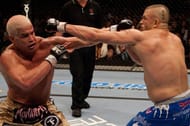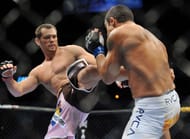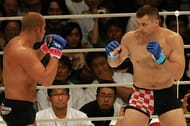
From its beginnings as a largely underground spectacle in the early 1990’s, the UFC has come a long way. Today, the UFC is a multi-billion dollar business, a mainstream sport that is viewed by millions on networks like ESPN and ABC. But are we really in the Golden Age for MMA? Perhaps it could be argued that the real Golden Age for the UFC came between 10 and 15 years ago, during the promotion’s initial boom period.
Sure, the pay-per-views didn’t sell as well back then, and the shows were broadcast on Spike TV rather than the ESPN juggernaut. Even so, there’s definitely something to be said for the UFC being a more entertaining product to watch back then.
With that in mind, here are five things we miss from the UFC’s initial boom period of 2005-2010.
Get the latest updates on One Championship Rankings at Sportskeeda and more
#1 The old-school UFC ‘gladiator’ introduction

Today’s UFC shows tend to start in a similar fashion. A quick, generic ESPN introduction followed by a video to hype up the main event, often with a voiceover from a famous actor like Ron Perlman or Ving Rhames.
Sure, that kind of introduction works well if it’s to hype up a fight like Conor McGregor vs. Dustin Poirier. But it doesn’t really come across so well if the main event of a show is a lesser UFC fight, like Neil Magny vs. Michael Chiesa, for example.
Rewind back to 2005 though, and the UFC used a much cooler introduction. Each show started in identical fashion – with some operatic music showing a Roman gladiator preparing for action, before the UFC’s main event fighters offered some soundbites about their upcoming clash.
Finally, the introduction would explode into life, with highlights of each fighter on the main card set to heavy metal track Face the Pain.
It was violent, it got the fans hyped, and in a word, it was awesome.
The ‘Gladiator Man’ introduction, as it was known, was finally retired in 2012, and Face the Pain lasted until around 2015 before it too vanished.
The newer style of introduction is more mainstream, but it doesn’t get the blood pumping like the old gladiator introduction did.
#2 Fighters being able to wear customised fight gear in the Octagon

In the five years that have followed the beginning of the much-maligned Reebok deal, it is true that the UFC’s fight gear has come a long way.
However, when that long way means that we’ve gone from fighters wearing black-and-white gear to a handful of other colors, it’s hardly revolutionary.
There’s simply no disputing that things were much better a decade ago when it came to fight gear.
The free-for-all system did mean that some fighters ended up with less-than-mainstream sponsors on their gear – the infamous ‘Dude Wipes’ logo comes to mind. But there were plenty of cooler aspects to it.
Who could forget Chuck Liddell’s famed ‘Iceman’ shorts? Or BJ Penn’s vale tudo shorts that incorporated a black belt into their design? And then there were Mirko Cro Cop’s Croatian flag shorts, Tito Ortiz’s flame design, Anderson Silva’s yellow-and-black colours, and so on.
Whether the UFC’s new apparel deal with Venum helps matters remains to be seen, but the current Reebok gear definitely makes UFC fans pine for the past.
#3 Fighters willing to fight without negotiating

One of the big downsides of the model of promotion used in boxing is that there’s far too much negotiation taking place to set up a fight. A big fight like Floyd Mayweather vs. Manny Pacquiao can take years to make due to squabbles about purse splits, pay-per-view providers and so on.
That’s not so much the case in the UFC, as the promotion still manages to largely put together the fights that fans want to see. However, in recent years, the matchmaking style has begun to creep closer and closer to the way things are done in boxing.
It’s becoming more common these days to see fighters turning down certain opponents because they won’t necessarily draw the most money. Just a few weeks ago, for instance, Dustin Poirier outright refused to fight UFC newcomer Michael Chandler.
And more and more often, UFC fighters attempt to renegotiate a new deal with the promotion before signing for a big fight, even if it’s a UFC title shot.
All of this makes fans pine for the days when the likes of Rich Franklin would simply sign with the UFC for a certain amount of fights, and work through them regardless of the opponents offered or their outcome.
Nobody is suggesting that the UFC should be able to take financial advantage of its athletes. But the sport is beginning to become too focused on money and not on the glory of actually winning – and that’s disappointing.
#4 Multiple promotions competing with the UFC

A sign of the massive success of the UFC is that the name of the promotion is now synonymous with the sport of MMA as a whole. In 2021, despite the existence of Bellator, the UFC really is the only big game in town when it comes to mixed martial arts.
Of course, it wasn’t always like that. Rewind to the period between 2005 and 2010, and there were multiple promotions attempting to compete with the UFC, and in turn, giving a much wider platform for the fighters to perform on.
Sure, it was frustrating at times that PRIDE superstars like Wanderlei Silva couldn’t fight their UFC counterparts like Chuck Liddell right away. But the fame that those fighters garnered in those rival promotions meant that once they did arrive in the UFC, it was a big deal.
But over the past fifteen years we’ve seen promotions like PRIDE, DREAM, StrikeForce, WEC and Affliction all die out, leaving the UFC and Bellator as the last two standing.
And that means that these days, UFC debutants tend to come in with very little fanfare, with the odd exception of jumping from Bellator like Michael Chandler.
There’s essentially no point in attempting to compete with the UFC these days, but that doesn’t mean that things weren’t cooler when various promoters did.
#5 UFC fighters making wild entrances

Ever since they got rid of the WWE-esque rampway in 2003, the UFC’s entrances have been far more understated than those in the world of pro-wrestling. However, despite that, we still used to get some classic wild entrances in the UFC a few years back.
Who doesn’t remember Yoshihiro Akiyama and his whole team kneeling in the entranceway to the sound of Con Te Partiro? Or Sokoudjou entering while wearing a Predator mask?
Even some of the goofier entrances were memorable, with Kenny Florian’s samurai outfit, Diego Sanchez's oversized crucifix and Tom Lawlor leading Seth Petruzelli to the Octagon on a dog’s leash coming to mind.
Today though, those kinds of antics are few and far between. That’s why UFC Middleweight champion Israel Adesanya garnered such attention with his haka entrance at UFC 243 in 2019.
Part of this issue stems from the UFC’s apparel deal with Reebok. UFC fighters are now encouraged to wear their Reebok fight gear to the Octagon, moving them away from outlandish outfits.
However, everything seems so serious in general for the UFC in the 2020’s. Even the music the fighters walk out to has become largely clichéd.
There’s no denying that the UFC’s fighter entrances have simply become more and more generic over the years. It’s just another example of something that was far better during the promotion’s earlier boom years.
